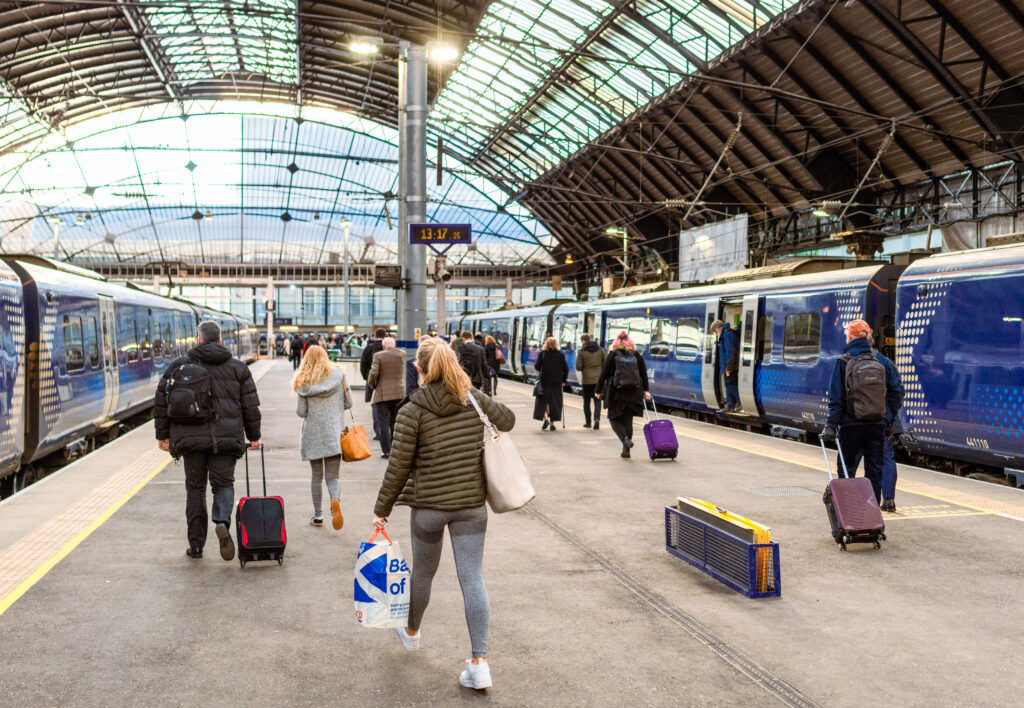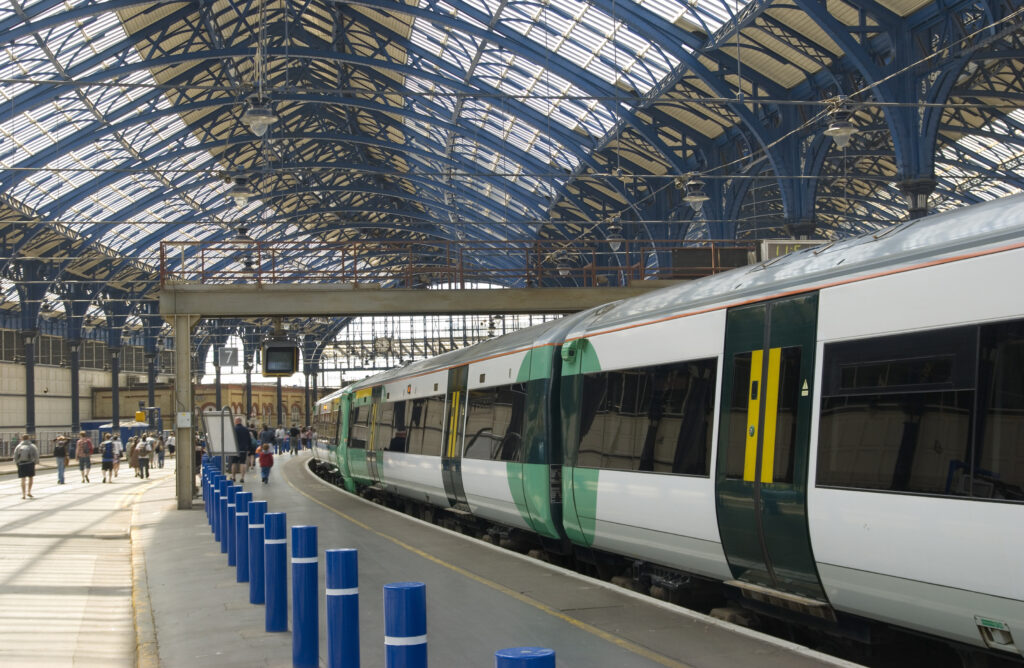Issue 197 of Rail Engineer (July/August 2022) featured timetabling and described why at the heart of every railway there must be a good, efficient timetable. There are many factors which must be carefully considered for an effective timetable, and this article looks at train dwell time at stations.
A train stopping for longer than timetabled at a station is a common cause of train delay. Most of these delays are small and are ‘sub-threshold’, meaning they do not go through the delay attribution process. But even delays of a few seconds can, when aggregated, adversely impact the overall performance and capacity of the network.
Train dwell time is the time a train spends at a scheduled stop without moving, while passengers deboard or board the train. This can be a complicated subject and depends on many factors. These include station and platform design, train design, passenger type and volume, and human factors / passenger behaviour. Interactions between passengers, stations, and trains, as well as interactions between passengers themselves, all make dwell time one of the most challenging factors in train operation, particularly in very busy railways such as metros.
Peak hour train service frequency in many rail systems can be limited by dwell times. Signalling technology has improved to enable trains to run closer together and more frequently, but this in turn creates more passenger volume, which then affects dwell times leading to possible conflicts at junctions and effecting signalling and traffic management. This can have a detrimental effect on the timetable. Factors such as train overcrowding, poor train design, and poor station layout can lead to excessive dwell times at multiple stations.
Station dwell time
Dwell time is defined in the IEEE 1471.1 Standard as “the time a transit unit (vehicle or train) spends at a station or stop, measured as the interval between its wheels stopping and starting”.
The time includes train door opening and closing times, passenger alighting and boarding times, door clear checking times, and any scheduled additional stopping time in the timetable or which may be required for train regulation purposes. In some railways it also includes time for Platform Screen Door (PSD) opening and closing. Normally there is a minimum dwell time to ensure that passengers can board and alight without getting hit by the closing doors.
Dwell times can vary according to type of railway and route. The train doors could close and the train departs when passengers have finished boarding, or the dwell time is set to a specific minimum time at a station or on the whole route – even if all passengers have not boarded (typical in busy metros), or the train doors are closed well in advance of scheduled departure time, so the train can depart exactly as per the timetable. On some railways and routes, say where trains generally wait for connecting passengers to board, dwell times can vary between different stations on the line and at different times of the day.

Design of trains and stations
Design factors affecting dwell times typically include:
- The number of trains on a route needs to accommodate the predicted passenger demands, otherwise overloaded trains will not meet dwell time targets. Sometimes train overcrowding, and greater dwell time, can be caused by cancelled trains due to poor rolling stock reliability and availability. This also includes train crew availability.
- We are all living longer and become less mobile as we age, so trains need to be designed so that passengers with mobility issues can still easily board and alight. The number of train doors and the internal design of trains will affect boarding and alighting times for everyone. Different train types, door positions, and small platforms may mean boarding passengers cannot keep clear of the doors to allow passengers to alight first.
- Busy trains need wide opening doors, but modern, safer, more crash resistant trains generally have fewer and smaller door openings than older trains. A ‘one way in, one way out’ train design with separate exit and entrance doors, as on some buses, would assist train passenger alighting and boarding, but this would be very difficult to implement and manage.
- Where train crew /drivers manually close the doors, they need to be able to clearly observe or obtain assurance from the platform staff that the train doors are clear of passengers. Where train crew may be carrying out other duties, such as checking tickets, they must be able to access the door opening controls when required. It is not unknown on some busy routes for a member of the train crew to have to push their way back through a busy train to their cab to open the doors, with the train stationary in the platform and passengers waiting to alight and board.
- Station entrances and exits along busy rail routes should ideally be varied to ensure more even train loading. Passenger flow modelling should be undertaken to ensure that passengers alighting from one train do not delay passengers boarding another. This is important where large numbers of passengers transfer between two trains at an island platform or where escalator capacity restrictions create large numbers of passengers on the platforms. For existing stations it may be possible to make modifications to ease the situation. Stopping door positions of trains should be easily identified and marked so passengers can ideally wait clear of doors.
- If a platform is lightly loaded with waiting passengers, then generally they stand back and leave space for alighting passengers. But if the platform is busy there can be a tendency for people to ‘move to the front of the queue’ in order to improve their chance of obtaining a seat. This may then affect passengers leaving the train and adversely impact the dwell time.
- Platform Screen Door (PSD) designs, while providing safety improvements and the ability to operate fixed dwell times, can add to average station dwell times. The door opening times can add two or three seconds and door closing times an extra five or six seconds. This can be a problem with trying to run frequent headways on some railways and may raise concerns with providing PSD’s. With railways that operate Automatic Train Operation (ATO), poor ATO accuracy may result in trains not aligning with the PSD doors, and requiring additional time for the train to align.
Station operation, passenger information and human factors
Some railways may have station staff available to make announcements to direct passengers to lightly loaded carriages and assist with train loading. In some parts of the world staff are provided to ‘greatly assist’ passenger loading – such as the white gloved ‘passenger pushers’ on the Tokyo metro. Announcements can also be made to inform passengers of service changes to assist loading, such as advising to wait for the next train if the expected train is very loaded.
Encouraging alighting passengers to prepare early by moving to the train doors prior to arriving at the station can help station dwell times. Regular commuter passengers are more likely to assist with this, although the days of ‘slam door’ stock and passengers opening the doors and alighting before a train has come to a standstill are no more. However, from a safety perspective, should passengers be encouraged to stand and move before a train comes to a stand? Leisure train users, who may also have large items of luggage, are more likely (but not always) to remain in their seats till the train comes to a stand anyway.
Train crew changes at station platforms will affect dwell times. If a guard arrives to open the doors just before a train departs at a terminal station, this can affect dwell times. Other factors, including passenger expectations, culture and behaviour need to a be considered. For example, the acceptable number of passengers per square metre varies around types of railways and the world. On some routes where there are long times between services, passengers may hold the doors open for others rather than wait for the next train, which increases dwell times.

Signalling and train control
Signals in conventional signalling are placed such that the signal design headway can be achieved within the line constraints without delaying the train, while allowing for signal sighting, equipment operation, and the specified station dwell times.
For timetabled services, the signal design will take into account operational differences, including extended dwell times, differences in driving styles, and different train types. The traditional way to cater for longer station dwell times is to design for the peak hour conditions for the predominate rolling stock. This should be based on real or predicted dwell time data for each station and not nominal, or there is a risk that the signalling may not achieve the specified line capacity.
Stopping patterns must also be considered with dwell times, and changing a station signalled as non-stop into a stopping station can affect overall line capacity. To achieve tight line headways, the signals approaching the station may need to be very closely spaced, placing additional speed restrictions on rolling stock with poor braking characteristics, which can further impact dwell times.
So, what can be done?
The Rail Safety and Standards Board (RSSB) IntelliDwellTime (IDT) demonstrator project developed a software solution that generates and analyses dwell data to a high level. The tool displays dwell time at every station stop on the network to the second, and breaks it down into three phases:
- Wheels stop to doors open
- Doors are open
- Doors closed to wheels start
The tool provides the ability to drill down to see dwell time variation across a wide range of parameters, such as by station or service.
The development of the IDT tool was led by Porterbrook, in collaboration with Abellio ScotRail, data science company Elastacloud, and the University of Southampton. The Abellio ScotRail data showed that over 40% of dwell time arises in the third phase, which interestingly means there is more time between doors closing and wheel start than between doors opening and closing.
IDT also correlates dwell time data with other factors, to help identify the root causes of delay. The tool could also be used to compare options and support operational or infrastructure alterations.
RSSB also did a feasibility study towards the development of a real-time digital twin to reduce dwell time variations on the Thameslink route. This project used simulations to establish correlations between delays and the flow and density of people at key nodes, such as ‘bottleneck’ stations. It opened a technical path for industry to improve dwell time performance through real-time passenger flow prediction and crowd management. Details of all the RSSB’s research work on dwell times is available on its Research Catalogue website.
Improving dwell times is not easy, but very often better measurement and management and making small changes to existing practices can make a difference – and much more cost effectively than redesigning stations and trains.

A study 10 years ago by the CoMET metro benchmarking group, identified that the key passenger issues on dwell times were: people boarding trains not letting people get off first; passengers holding or blocking doors; passengers crowding doors and vestibules; and passengers bunching on platforms.
Traditional solutions to these problems included publicity campaigns, signs, and announcements. However, people soon get bored with static signage and repeated announcements, which blend into the background and are ignored. So, the messages must be dynamic and campaigns regularly changed, and announcements must use a variety of phrases that are appropriate to the situation. Effective platform and train staff can make announcements to reduce crowding and the risk of repeated door closures, to encourage more efficient passenger movement, and they can assist passengers with reduced mobility.
Technology and signage are also evolving to persuade passengers to change their behaviours. More real-time data enables a better understanding of train loading and crowding, allowing more to be done to improve things. Systems to show the space available on trains in each carriage are also now available, which can provide passengers with increased confidence that they will find a seat and aid them in doing so. This could mean moving down the platform to a less busy part of the train or waiting for the next less busy train.
Summary
Train dwell times at stations is a complex subject with many factors, and even a delay of a few seconds at multiple stations can have a dramatic effect on a timetable. It is a subject that needs a system approach, including station and train design, signalling, passenger information, human behaviours, communications, operations, new technologies, and ways of working to minimise the impact on the operational railway.
Image credit: istockphoto.com


